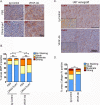Anti-angiogenic therapy increases intratumoral adenovirus distribution by inducing collagen degradation
- PMID: 22673390
- PMCID: PMC3443547
- DOI: 10.1038/gt.2012.42
Anti-angiogenic therapy increases intratumoral adenovirus distribution by inducing collagen degradation
Abstract
Conditionally replicating adenoviruses (CRAd) are a promising class of gene therapy agents that can overcome already known glioblastoma (GBM) resistance mechanisms but have limited distribution upon direct intratumoral (i.t.) injection. Collagen bundles in the extracellular matrix (ECM) have an important role in inhibiting virus distribution. In fact, ECM pre-treatment with collagenases improves virus distributions to tumor cells. Matrix metalloproteinases (MMPs) are an endogenous class of collagenases secreted by tumor cells whose function can be altered by different drugs including anti-angiogenic agents, such as bevacizumab. In this study we hypothesized that upregulation of MMP activity during anti-angiogenic therapy can improve CRAd-S-pk7 distribution in GBM. We find that MMP-2 activity in human U251 GBM xenografts increases (*P=0.03) and collagen IV content decreases (*P=0.01) during vascular endothelial growth factor (VEGF-A) antibody neutralization. After proving that collagen IV inhibits CRAd-S-pk7 distribution in U251 xenografts (Spearman rho=-0.38; **P=0.003), we show that VEGF-blocking antibody treatment followed by CRAd-S-pk7 i.t. injection reduces U251 tumor growth more than each individual agent alone (***P<0.0001). Our data propose a novel approach to improve virus distribution in tumors by relying on the early effects of anti-angiogenic therapy.
Figures







Similar articles
-
Survivin-driven and fiber-modified oncolytic adenovirus exhibits potent antitumor activity in established intracranial glioma.Hum Gene Ther. 2007 Jul;18(7):589-602. doi: 10.1089/hum.2007.002. Hum Gene Ther. 2007. PMID: 17630837
-
Neural stem cells target intracranial glioma to deliver an oncolytic adenovirus in vivo.Gene Ther. 2009 Feb;16(2):262-78. doi: 10.1038/gt.2008.165. Epub 2008 Dec 11. Gene Ther. 2009. PMID: 19078993 Free PMC article.
-
Pharmacokinetic study of neural stem cell-based cell carrier for oncolytic virotherapy: targeted delivery of the therapeutic payload in an orthotopic brain tumor model.Cancer Gene Ther. 2012 Jun;19(6):431-42. doi: 10.1038/cgt.2012.21. Epub 2012 May 4. Cancer Gene Ther. 2012. PMID: 22555507 Free PMC article.
-
Tissue inhibitor of metalloproteinase-3 expression from an oncolytic adenovirus inhibits matrix metalloproteinase activity in vivo without affecting antitumor efficacy in malignant glioma.Cancer Res. 2005 Oct 15;65(20):9398-405. doi: 10.1158/0008-5472.CAN-04-4264. Cancer Res. 2005. PMID: 16230403
-
N-acetylcysteine amide augments the therapeutic effect of neural stem cell-based antiglioma oncolytic virotherapy.Mol Ther. 2013 Nov;21(11):2063-73. doi: 10.1038/mt.2013.179. Epub 2013 Jul 25. Mol Ther. 2013. PMID: 23883863 Free PMC article.
Cited by
-
Glioma virus therapies between bench and bedside.Neuro Oncol. 2014 Mar;16(3):334-51. doi: 10.1093/neuonc/not310. Epub 2014 Jan 26. Neuro Oncol. 2014. PMID: 24470549 Free PMC article. Review.
-
Encapsulated stem cells loaded with hyaluronidase-expressing oncolytic virus for brain tumor therapy.Mol Ther. 2015 Jan;23(1):108-18. doi: 10.1038/mt.2014.204. Epub 2014 Oct 29. Mol Ther. 2015. PMID: 25352242 Free PMC article.
-
Folic acid-decorated polyamidoamine dendrimer exhibits high tumor uptake and sustained highly localized retention in solid tumors: Its utility for local siRNA delivery.Acta Biomater. 2017 Jul 15;57:251-261. doi: 10.1016/j.actbio.2017.04.023. Epub 2017 Apr 22. Acta Biomater. 2017. PMID: 28438704 Free PMC article.
-
Oncolytic Immunotherapy: Conceptual Evolution, Current Strategies, and Future Perspectives.Front Immunol. 2017 May 15;8:555. doi: 10.3389/fimmu.2017.00555. eCollection 2017. Front Immunol. 2017. PMID: 28555136 Free PMC article. Review.
-
In Vivo Oncolytic Virotherapy in Murine Models of Hepatocellular Carcinoma: A Systematic Review.Vaccines (Basel). 2022 Sep 16;10(9):1541. doi: 10.3390/vaccines10091541. Vaccines (Basel). 2022. PMID: 36146619 Free PMC article. Review.
References
-
- Stupp R, Hegi ME, Mason WP, van den Bent MJ, Taphoorn MJ, Janzer RC, et al. Effects of radiotherapy with concomitant and adjuvant temozolomide versus radiotherapy alone on survival in glioblastoma in a randomised phase III study: 5-year analysis of the EORTC-NCIC trial. Lancet Oncol. 2009;10(5):459–66. - PubMed
-
- Ulasov IV, Zhu ZB, Tyler MA, Han Y, Rivera AA, Khramtsov A, et al. Survivin-driven and fiber-modified oncolytic adenovirus exhibits potent antitumor activity in established intracranial glioma. Hum Gene Ther. 2007;18(7):589–602. - PubMed
Publication types
MeSH terms
Substances
Grants and funding
LinkOut - more resources
Full Text Sources
Other Literature Sources
Miscellaneous

